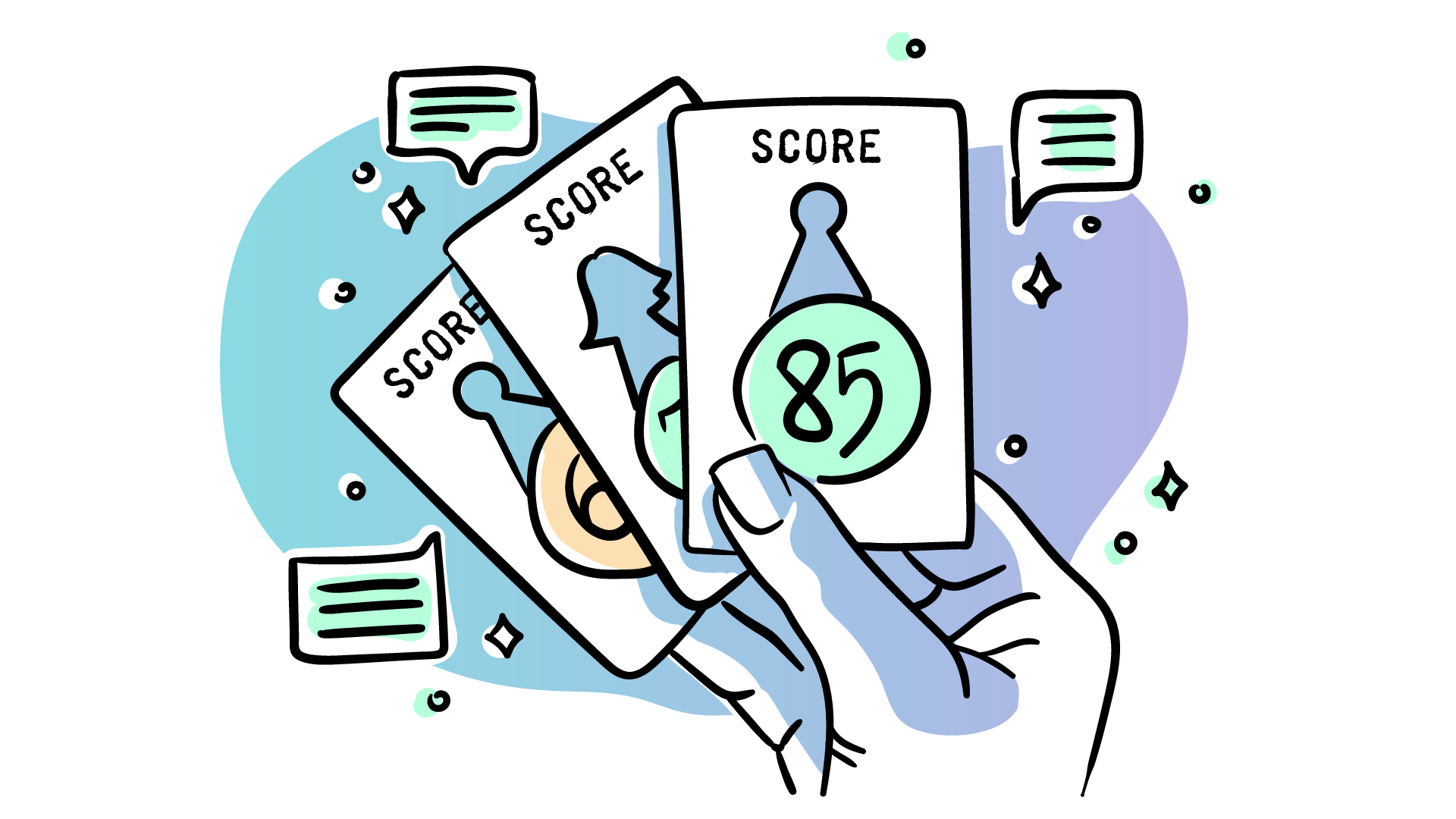
April 15, 2024 Lead Scoring: The Quantitative Approach
Lead scoring has become a fundamental tool in sales and marketing, as it offers a strategic approach to quantifying the potential of leads. In essence, lead scoring consists of assigning a numerical value to each lead based on a number of factors, such as their interaction with a brand's website, responsiveness to emails and engagement with content. This method allows companies to systematically assess where a lead is in the buying process, moving from mere interest to readiness to sell. By prioritizing leads based on their scores, companies can allocate their efforts more efficiently, focusing on the leads most likely to convert.
In this blog, we will explore the importance of lead scoring and how you can make the most of it for your company.
Understanding Lead Scoring
Lead scoring is a systematic method used to rank prospects against a scale that represents the perceived value each lead brings to the organization. This process involves assigning numerical points to each lead based on specific, predetermined criteria such as their behavior on your website, engagement with emails, and the relevance of their professional profile to your target market. The sum of these points gives each lead a total score, enabling teams to quantify a prospect's readiness to buy and their alignment with the company’s ideal customer profile.
At its essence, lead scoring democratizes the process of evaluating leads. It moves beyond gut feelings and subjective interpretations, anchoring decisions in concrete data. Historically, sales and marketing assessments relied heavily on qualitative data—impressions, experiences, and personal judgments. While these insights are invaluable, they are inherently subjective and difficult to scale or standardize across an organization and provide no indication if a lead is ready to purchase Lead scoring marks a significant shift towards a more objective, measurable, and consistent approach of identifying when a lead hotter or colder in your marketing funnel and sales pipeline
This transition from a subjective assessment to a numerical, data-driven approach allows teams to prioritize leads more effectively. High-scoring leads are identified as those most likely to engage positively with marketing and sales efforts to make a purchase, while lower-scoring leads may require more nurturing or are not interested in your services. By prioritizing high-scoring leads, businesses can ensure that sales efforts are focused on the leads that are most prepared to move forward in the sales process, thus increasing efficiency and the likelihood of conversion.
The Components of Lead Scoring
Lead scoring requires taking a qualitative assessment of a contact’s interactions with your business and translating it into a numerical system that can be implemented. This process involves assigning a score to each lead based on their activities and engagement level. Factors might include website interactions, email responses, or content downloads. The scoring system should be standardized across your marketing and sales departments to ensure everyone is aligned on the lead's placement within the sales funnel.
This numeric value helps determine a lead's current position on the scale from merely "interested" to "ready for a sale," enabling you to prioritize follow-up efforts and tailor communication effectively. The exact criteria for scoring will vary based on your business's unique needs and the specific behaviors that indicate a lead's readiness to proceed to the next stage in your sales pipeline.
The components influencing lead scores can be broadly categorized into demographic information, online behavior, engagement levels, and social media activity. By assigning scores to these different factors, businesses can create a comprehensive profile of their leads, enabling a more targeted and efficient sales approach.
1. Demographic Information
Demographic factors include details about the lead's industry, job role, company size, and location. These elements are crucial because they help determine whether a lead fits within the target audience or buyer persona of the business. For example, a lead in a senior management role at a mid-sized tech company might receive a higher score if the company's products or services are designed for such organizations and positions. Demographic scoring ensures that attention is focused on leads most likely to benefit from and purchase the offering.
2. Online Behavior
This aspect of lead scoring tracks how leads interact with a company's website and online assets. Actions such as visiting specific pages, spending time on the site, returning visits, and downloading whitepapers or case studies are scored to gauge interest level and intent. For instance, a lead that frequently visits the pricing page or downloads a product datasheet might be considered closer to a purchasing decision and thus receive a higher score.
3. Email Engagement
Email interactions provide valuable insights into a lead's interest and engagement. Metrics such as open rates, click-through rates, and responses to email communications are indicative of a lead’s interest. A lead who consistently opens emails and clicks on links is likely more engaged and interested in the offerings than one who does not, leading to a higher score.
4. Content Downloads
The types of content a lead downloads can also influence their score. Educational content such as ebooks, webinars, and industry reports might indicate early-stage interest, while product brochures and case studies suggest a readiness to consider specific solutions. Each content type can be scored differently to reflect the lead's stage in the buyer’s journey.
5. Social Media Activity
Social media interactions, such as following the company’s profiles, sharing its content, or engaging with it through comments and likes, are also telling. Such activities can signal a lead's interest and engagement level, contributing positively to their overall score.
Assigning Scores to Behaviors
The process of assigning scores to these behaviors and interactions involves defining a scale (e.g., 1 to 100) and determining the value of each action within that scale. The criteria and scoring system should be customized to reflect the business's sales cycle and the actions that historically indicate a lead’s likelihood to purchase. This system requires regular review and adjustment to remain aligned with changing behaviors and market dynamics.
Call out: When creating a lead scoring model it works best to create separate lead scores for demographic alignment, email behavior, online engagement etc. Creating multiple lead scores along with an aggregate score adds depth and precision to the lead qualification process, enabling more targeted marketing and sales efforts.
Steps to Develop a Lead Scoring Model
Setting up a lead scoring system requires careful planning and collaboration, especially between sales and marketing teams, to ensure it effectively identifies the most promising leads. Here’s how you can develop a lead scoring model tailored to your business needs:
- Define Your Ideal Lead Profile: Begin by identifying the characteristics of your ideal customer. Look at demographic factors (industry, company size, job role), behaviors (website engagement, email interaction), and other pertinent criteria that align with your most successful conversions.
- Assign Scores to Various Criteria: Once you have identified the key characteristics and behaviors of your ideal lead, assign scores to each based on their perceived importance in indicating purchase intent. More significant actions or alignments with the ideal profile should receive higher scores.
- Set Up a Scoring System in Your CRM: Utilize your Customer Relationship Management (CRM) software to automate the scoring process. Most CRM systems offer features to help implement lead scoring, tracking each lead's interactions and automatically updating their scores.
- Align Sales and Marketing Teams: Ensure that both sales and marketing teams agree on defining a qualified lead. This alignment is crucial for standardizing lead scoring criteria and ensuring both teams work towards the same goals.
- Test and Adjust: Start with a pilot program to test the effectiveness of your lead scoring model. Analyze the results and make necessary adjustments to the scores and criteria based on feedback from the sales team and conversion rates.
- Regular Review and Update: Lead scoring models are not set in stone. Regularly review the model to adjust for changes in buying behaviors, market conditions, or your business objectives.
The Role of Marketing and Sales Alignment
The success of a lead scoring system heavily depends on the alignment between marketing and sales teams. Both teams must agree on what constitutes a qualified lead and understand the journey those leads take from initial interest to becoming a customer. Regular meetings to discuss the effectiveness of the scoring model and to adjust the scoring criteria ensure that the system remains relevant and continues to support the sales process efficiently.
Examples of Scoring Criteria for Different Industries
B2B: Score leads higher for actions that indicate a high level of interest and authority, such as downloading technical whitepapers, attending a product demo, or holding a managerial or higher position in IT or operations.
E-commerce: Prioritize leads who have a history of frequent purchases, high order values, and engagement with promotional emails or social media campaigns.
Education Services: Assign higher scores to leads who attend webinars, download course catalogs, or inquire directly about specific courses, indicating a strong interest in pursuing education.
Healthcare Services: For healthcare, leads interested in specific treatments or who engage with patient testimonials and service explanations might score higher, indicating they are closer to choosing a provider.
Final Thoughts
Implementing a lead scoring system is a powerful strategy for businesses looking to optimize their sales and marketing efforts. By quantitatively assessing the potential of each lead through a data-driven approach, companies can prioritize their resources effectively, focusing on prospects that are most likely to convert into customers. The process involves several key steps, including defining the ideal lead profile, assigning scores based on various criteria, and ensuring alignment between sales and marketing teams to standardize the lead scoring criteria.
The beauty of lead scoring lies in its flexibility; the system can be tailored to meet the unique needs of different industries, from B2B technology to e-commerce, education services, and healthcare. By assigning higher scores to leads based on their behaviors and engagement levels that indicate a readiness to buy, businesses can streamline their sales funnel and enhance the efficiency of their sales cycle.
However, the effectiveness of a lead scoring system is not set in stone. It requires ongoing collaboration between sales and marketing, regular reviews, and adjustments to reflect changing market conditions and business objectives. When done right, lead scoring not only helps in identifying the most promising leads but also improves the alignment between sales and marketing, leading to better communication, more efficient processes, and, ultimately, higher conversion rates.
In an era where data is king, lead scoring is a crucial component of a successful sales and marketing strategy. It empowers businesses to make informed decisions based on objective criteria, ensuring that effort is directed towards leads with the highest potential for success. As we move forward, the importance of a sophisticated, data-driven approach to lead management cannot be overstated.
Maximize your conversions with a tailored lead scoring system with SEO Fundamentals. Get in touch today to focus your efforts where they count the most!
READY TO TRANSFORM YOUR BUSINESS?
Book a Free Consultation & Learn how we can help your business grow.
Desireé Solís
Skilled content marketing expert with four years of experience, specializing in impactful, innovative strategies that boost brand visibility and engagement. Her expertise spans content creation, brand strategy, storytelling, and social media marketing. Renowned for her versatility, Desireé adeptly tailors her approach to meet various brand challenges and goals, showcasing an exceptional ability to adapt and excel across different marketing landscapes.

